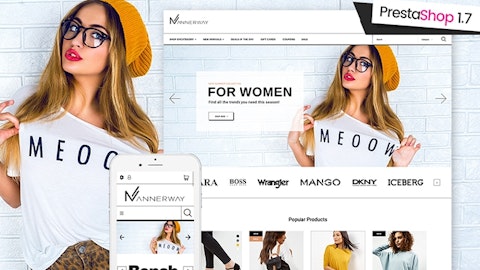Barry McCarthy: I would say about the demand environment, uncertain. We’ve seen consumers respond very favorably to promotional activity in the current environment, maybe even more so than historically. There’s certainly no exuberance in the marketplace, but it’s not frozen either. So it’s kind of a mixed bag, and we’re definitely uncertain about what’s next in terms of the economic environment. Maybe the recession is soft landing. What happens with jobs. How uncertain your people. It seems like household incomes who had money still have money, they’re able to spend. And then there’s everybody else. For them, there’s a lot of uncertainty.
Liz Coddington: Yes. And while there’s certainly uncertainty. When we do our demand forecasting, we incorporate the latest trends that we see into our bottoms-up forecast. And so we believe our guidance contemplates some of that macroeconomic headwinds that may be — that we may be observing, even though it’s hard to explicitly identify what they are.
Barry McCarthy: But we — and since we have no explicit assumption around what’s going to happen in Washington around the and the blast radius associated with the inability of Congress to resolve that with the President, just by way of example. So we’re assuming the world continues on as we know it today, we’ll see.
Operator: Thank you. One moment for our next question, that will come from the line of Andrew Boone with JMP Securities. Your line is open.
Andrew Boone: Hi, good morning and thanks so much for taking my question. Barry, I wanted to ask now that we’re a year into the price increase. Just philosophically how you are thinking about subscription price increases going forward. Given your time in Netflix, it felt like there was a steady cadence Does that relate to Peloton?
Barry McCarthy: I don’t think so. For the longest time, Netflix’s strategy was actually to reduce price and grow share. And it was only after they became dominant on a global basis did they extract a premium from the marketplace associated with the share. So left to my own devices, I would be lowering prices, not raising prices. I think it’s a very effective way to drive a virtuous cycle of increased engagement, increased word to map, lower marketing expense. You can increase value by making trade-offs against gross margin. And I would like us to be able to do that, but I don’t foresee that being possible given the financial constraints of the business. You will see, as Liz commented increasing gross margins that are a function of structural shifts in the business, for instance.
And that relates to the rate of growth in the subscription business versus the hardware business. So by way of example, last quarter, subscription revenue exceeded hardware revenue by $30 million. This quarter, it exceeded by $100 million. It’s growing significantly faster. I think that is a long-term trend in the business as I flagged, I think, in last quarter’s investor letter. And — but I don’t foresee big structural changes in the gross margin of the subscription business itself or even of the hardware business itself.
Liz Coddington: Excluding the restructuring charges.
Barry McCarthy: And eventually, that too would be in the rear view mirror.
Andrew Boone: And then I just wanted to touch on the underlying new subs that are coming on the platform. Are you guys seeing any change there in terms of income or age? Or anything else that would be worth highlighting? Thank you so much.
Barry McCarthy: No, not so much. With respect to the new marketing campaign, we will be reaching slightly younger. But that’s a TAM play and an inclusivity play. But no changes, particularly. I have noted previously that as we’re bringing in a slightly different demographic. It was slightly more female. It was high household income, interestingly enough. Is it professional women who value the optionality, that continues to be true. But it’s not skewing the macro numbers, particularly.
Operator: Thank you. One moment for our next question, that will come from the line of Mario Lu with Barclays. Your line is open.
Alex Hughes: Great. Thanks, guys. This is Alex Hughes on for Mario. Just had a couple of questions around the rower product. Do you have any updates on sales versus your internal expectations for that? And you guys launched the live rowing classes last quarter. Any update on user traction on that or how that’s progressing? Thanks.
Barry McCarthy: You want to talk about sales versus expectations?
Liz Coddington: We aren’t sharing explicitly what our sales are for the rower, but it is still a new product. And similar to what Barry said, our — it doesn’t have a high unaided awareness yet. So one thing to point out is that our current sales are actually pretty heavily skewed to our existing Connected Fitness subscribers, which is similar to what we saw with our Tread when we launched it. And so we are expecting sales to be more accretive to sub growth over time as to continue to build over time as we grow our unaided awareness of the product.
Barry McCarthy: Let me add that it received very favorable critical reviews. I think it’s made it much more difficult for some of the competitors in that space in particular. So it’s grabbed a lot of share. Liz mentioned that the awareness is still low. I think we have opportunities to work on that. Frankly, we didn’t really know what to expect when we launched it. And that — but the combination of the favorable critical reviews and then the reception from our users has been quite good. It’s slight — weighted — Net Promoter Score is slightly below the Tread product. So think of it is on par with Bike and Tread, which I think for a new product is pretty good. I think we have opportunities to continue to improve the content, but it’s a new category for us, and I’m confident that we will. But that’s not based on any research, by the way, that’s just my own assessment as a user.
Liz Coddington: And then I just want to add, it’s only available in the U.S. today, and we are looking to launch it internationally into other markets over time.
Operator: One moment for our next question, that will come from the line of Deepak Mathivanan with Wolfe Research. Your line is open.
Unidentified Analyst: Great, thanks. This is (ph) on for Deepak. Just first on marketing, just given with the brand relaunch and the app relaunch later this month, how that could affect kind of the typical seasonality of marketing spend this year, or over the next couple of quarters, kind of relative to historical periods? And then second, just on SaaS. Churn stepped up a little bit kind of quarter-over-quarter, now at 5%. Kind of how do we — obviously, it’s still early days. But how do we think kind of about the key drivers to kind of bring that down over the long term and that kind of give you confidence in the kind of the unit economics of that model over the long-term? Thanks.
Barry McCarthy: Liz and I will tag-team this. In terms of seasonality, marketing expense Q-over-Q will decline this quarter versus last quarter, but it will be up slightly single-digit percentages kind of on a year-over-year basis. It was quite low a year-ago Q4. And other than that, I don’t expect particularly any big changes in the seasonal pattern. And the reason it’s up year-over-year is, of course, is because we’re leaning into the launch of app. In terms of churn from my Netflix experience, I would say, it’s all about the user experience. Sorry, I may be more clear, we report average churn. Average churn is a function of the average life of the user base. If you’re pumping in a lot of new subs, they’re going to turn at a higher rate than subsequently with your service for a long period of time, like say, 12 months.
I’ve seen that in every subscription business that I’ve been a part of, and I’ve been a part of three of them now. Churn declines over time. And my last two businesses, it was asymptotic at 12 months. We see something similar here. So when growth accelerates, churn picks up slightly. When growth slows down, the average reported churn ticks down. So to really understand what’s happening with churn, you need to actually see the cohorts and see how, over time, the churn curve, is the slope changing? Is it shifting in parallel? Like what it’s happening? And that’s how you drive increases in lifetime value. So having said that, how do you bend the shape of the churn curve? You do that with engagement, largely. And you do that by controlling the quality of the subscribers that you acquire.
And so let me start there. That’s all about — the responsibilities for that rest with marketing. And if — again, you can generally judge how valuable a customer is going to be based on their retention very early in their life. And so you just have to self-regulate and acquire subs from sources that are going to meet your expectations in terms of churn. In terms of engagement. Let’s say, the last three quarters, we’ve seen a pretty good improvement about 5 percentage points in the base of customers, let’s say, who are engaged with all access product. The key, of course, is for Jen Cotter and her team of instructors continue to make great content. But that all by itself is not sufficient. If we make great content, but you can’t find it, when you hop on your bike or tread or row might as well not exist.
And so the product team, the engineering team used to be great at driving personalization. And we have made that an investment priority when I walked in the door. I think we’re making a lot of good progress there. We’re also introducing some new categories of content, like Lane Break, where we’re seeing really off the charts, kind of, engagement and give a slightly more male and a much younger MO. So we need to continue to — the same thing with Power Zones, by the way. So we need to continue to lean into those use cases, lean into personalization. Sorry to be so long-winded.
Liz Coddington: I wanted to add just a couple of quick things. First of all, first-half, I do want to comment that we are still within that 18 to 20 month payback period that we have been targeting, even with the slight uptick in churn that we’ve seen. And then Barry comments about sales and marketing. So our sales and marketing overall expense is actually down, expected to be down year-over-year in Q4, but our media spend is expected to be up. So the overall sales and marketing function itself, which includes down year-over-year, but we’re spending a bit more on media, to your point, around the brand we launch and the app.
Barry McCarthy: Well, Fast as a great example of how it is you can make trade-offs between marketing spend, churn, growth in order to drive more overall profitability in the business. So Fast absolutely had the higher churn rate, but the incrementality is in the low 60s. And so even though the lifetime value, we estimate to be, in round numbers, half that of an All Access member, we’re growing so much faster because of Fast, we’re driving more profit. And so we’re willing to take the churn hit because of the increase in enterprise value that results from us deploying that strategy.
Operator: Thank you. One moment for our next question, that will come from the line of Dana Telsey with Telsey Advisory Group. Your line is open.
Dana Telsey: Good morning, everyone. As you think about the shift of the business model and the relaunch of the app — or the launch of the app that’s coming, how do you see the shape of what the financial profile of the company should look like? Does the cadence quarterly or revenue streams, how you envision the mile on a quantitative basis?
Liz Coddington: Well, I’m not sure I fully understand the question. But as we’ve talked about, our business has shifted more towards subscription relative to Connected Fitness hardware. So as the app growth as a larger share of our business, that will continue to shift, and more of our revenue will be coming from subscription. And as we know, the gross margin of our subscription business is higher, so that will also continue to help improve our gross margins overall. And it will expand the business. We’ll continue to grow. We’ll be able to get scale, which will mean that our OpEx as a function of revenue will come down. So it’s leading us all in the right direction towards getting to our North Star goal, which is to be a bigger business with more subscribers and higher operating income and getting us to operating income breakeven over time.
But structurally, it’s really more about that shift that we’re continuing to see happen from the mix of Connected Fitness hardware to subscription. Now that doesn’t mean that some of those app subscribers over time will also become Connected Fitness members, but we’re going to have to see how that journey evolves, and we’ll have products available for them however they want to join Peloton.
Barry McCarthy: Building off of Liz’s comments. If we’re successful in growing the app business, we become increasingly an asset-light model. and it most definitely will change the working capital attributes of the business in a favorable way. Not to — at the risk of something like captain obvious. And the margins will benefit as a result, both the gross margin and the operating margins.
Liz Coddington: Right. And remember, our North Star around growth is LTV to CAC ratio. So we’re going to continue to evaluate how we grow our subscriber base in that framework.
Barry McCarthy: I would tell you — and if we’re successful in deploying an asset-light model, we’d probably see faster growth in international. It’s much easier to launch internationally an app product then it is hardware business, for sure.
Dana Telsey: And Barry, just following up on international, where international grew faster than the U.S. this quarter. What are you seeing internationally and leaning into the hospitality business, how do you see the pace of adds for new hospitality change joining the platform?
Barry McCarthy: I’m going to hold off on answering that. I appreciate the question. I think hospitality for us primarily is a U.S.-based business, at least for the coming fiscal year. And then I think there’ll be opportunities for us to go beyond that. And in terms of international growth, I’m thinking primarily existing markets with a few additional new markets. But it’s mostly — it’s re-architecting our go-to-market strategy in existing markets with increasingly culturally relevant content that unlocks the growth opportunities of those markets, pursue some co-branding opportunities for us. Just not a strategy that we’ve deployed. I think we’re going to have an exciting announcement, by way of example, over the next couple of quarters in that regard to help accelerate our growth.
Operator: Thank you. One moment for our next question, that will come from the line of Youssef Squali with Truist Securities.





